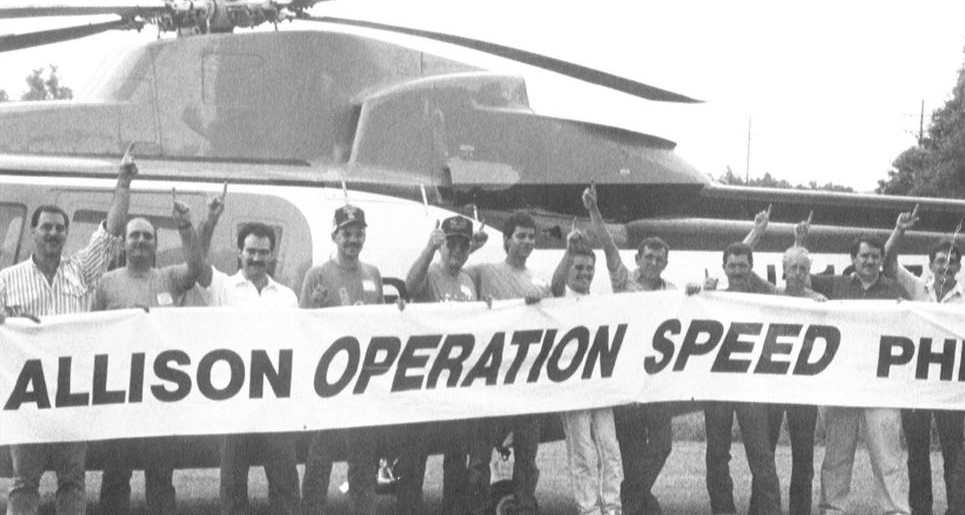

15 S76 Records Set in Week | The JetAv Blog by Jack Schweibold.
“Jack, go lease an S76 helicopter and set as many records as possible with our new C30 engines”, I was told as Supervisor of Flight Test, Allison Engine Company. Wow, that was like giving a teenager a new convertible, a bottomless credit card and instructions to drive his friends around the country, FAST. Then, to my amazement, he continued, “You set most of the records. We know you are gracious enough to share them with our friends in the industry. Have fun. I wish I was going with you!”
We did just that twenty-five years ago, starting with our friends at Petroleum Helicopter, Inc. in Lafayette, Louisiana. At that time, next to the U.S. and Russian military, PHI had the third largest fleet of helicopters in the world; most powered by our engines. By leasing one of their Sikorsky S76 helicopters, utilizing two of our upgraded C30’s, we proceeded to set or beat over a dozen speed, distance, altitude, time-to-climb and coast to coast records. We incorporated some flights into practical applications, like one weight-class speed record flown from the historic first off-shore oil rig in the Gulf of Mexico to a hospital in Houston . . . simulating an emergency medical evacuation rescue highlighted by local media, all good advertisement for PHI and Allison.
While operating out of Lafayette, we utilized many of their pilots and ours, spreading excitement to their staff and encouragement to ours. I held my attempts until departing Lafayette to Indianapolis, setting the heavyweight class distance record non-stop to Detroit. We had fabricated and installed three large rectangular fuel tanks, giving us wall-to-wall fuel storage across the aft cabin with jump seat space for a couple of riders. We were on our way enroute New York City to attempt the first coast-to-coast helicopter record, ROUNDTRIP!
In NYC, I picked up two of our company pilots, Harry Sutton and Fritz Harvey. Departing at daybreak the next day, we proceeded westbound stopping only three times for fuel in Indianapolis, Wichita, and Albuquerque. During fuel stops we would refuel, check the ship and be airborne within ten minutes . . . pit stops inspired by our Indianapolis auto racing. Nighttime found us over the Grand Canyon with the 3rd man sleeping in shifts atop the rear tanks. We cleared the San Juncito Mountains at 12,000’ to take advantage of the westerly flowing Santa Anna winds, passed over the Seal Beach Radio Beacon in Los Angeles completing the first East to West helicopter flight in less than one day, only 19 hours. Turning back eastward at the coast, we made a high rate descent into Riverside Airport for fuel. Passing through 7,000-feet in the descent we heard two muffled “boom, booms” from the rear compartment. Checkout while refueling indicated everything was okay. We only fueled to half the auxiliary tank levels, since we would have better winds after we crossed the desert heading east.
Our second and final refueling eastbound was at Saint Louis. We bypassed Lambert International due to weather lowering below 500-feet and less than a mile visibility. Heavy weather was laying over the whole Eastern part of the continent; the Appalachians would certainly have heavy rain and low visibilities and ceilings. These conditions were already reported in NYC, not encouraging for night operations even in an all weather helicopter. While fueling we grabbed a hamburger at the restaurant overlooking the ramp.
Anxiety set in as we moved toward that final take-off for NYC. We’d have to make our final decision enroute before passing over the Appalachians. Running to the ship while tucking the last remnants of hamburger in our flight suits, we were stunned to find the big Sikorsky sitting in the center of a 200-foot diameter lake of jet fuel glistening and expanding in the ramp lights!
Apparently, those two muffled “boom, booms” in California were two of our large fuel tanks rupturing during the high rate descent after clearing the mountains. The fuel vents were large enough to vent fuel burned but were not large enough to return heavier air to empty tanks during descent … too much outer pressure ruptured the upper seams in two tanks. Since we only filled the tanks half-way in California, they didn’t show leakage until they split when full here on the ramp. God can be seen in the whole operation, had the tanks split at night enroute in weather, ground observers may have seen the explosion only as a bolt of lighting in the clouds. He made the decision to terminate the flight when weather conditions could have become disastrous to the foolhardy. The next day weather was reported below minimums up and down the entire East Coast. Total records set in a week … 15 speed, time-to-climb, altitude and distance. The NY to LA speed of 130 mph probably still stands today, not to shabby considering that was against winds and with fuel stops!
